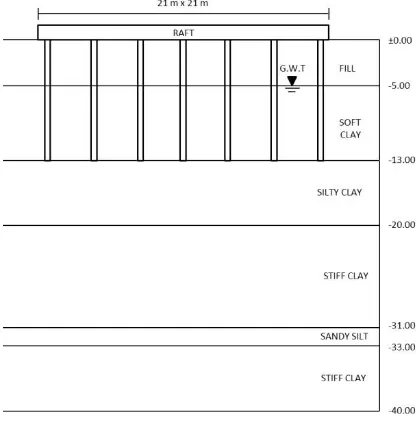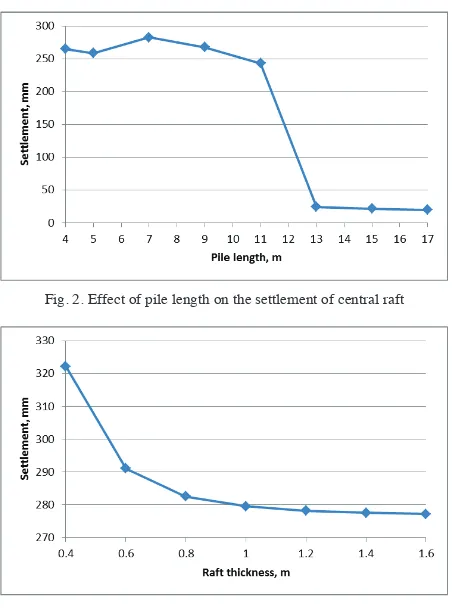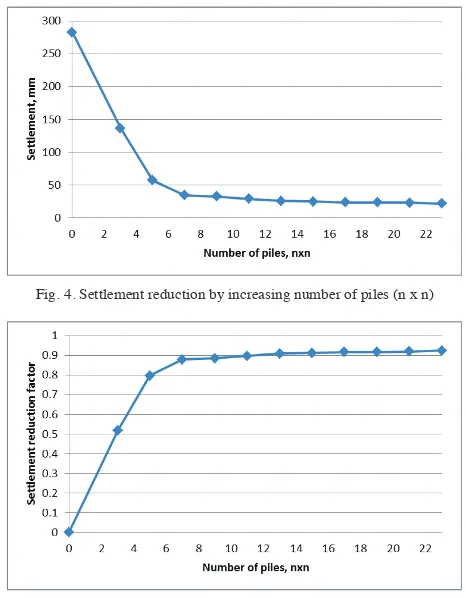Procedia Engineering 125 ( 2015 ) 363 – 367
1877-7058 © 2015 The Authors. Published by Elsevier Ltd. This is an open access article under the CC BY-NC-ND license (http://creativecommons.org/licenses/by-nc-nd/4.0/).
Peer-review under responsibility of organizing committee of The 5th International Conference of Euro Asia Civil Engineering Forum (EACEF-5) doi: 10.1016/j.proeng.2015.11.083
ScienceDirect
The 5th International Conference of Euro Asia Civil Engineering Forum (EACEF-5)
Analysis of piled raft foundation on soft soil using PLAXIS 2D
Paravita Sri Wulandari
a,*, Daniel Tjandra
aaPetra Christian University, Siwalankerto 121
– 131, Surabaya 60236, Indonesia
Abstract
Recent years, there are many construction projects constructed on soft soil. Due to the characteristics of soft soil, the structures built on it are subject to differential settlements. Raft foundation is one of the methods for reducing the differential settlement. Although it has an adequate bearing capacity, it may cause excessive settlement. Piles can be used with a raft foundation as a piled raft foundation system. The addition of piles is to reduce the settlements to an acceptable amount. The aim of this study is to analyze the settlements of the raft foundation and by adding piles, as the pile raft foundation, under the same loading. The numerical analysis has been done by finite element method using PLAXIS 2D with considering the various number of piles. As the results, the addition of piles could reduce the settlement, but after reach a certain number of piles, increasing the number of piles showed the settlement tends to be constant. For an economic design, it is necessary to consider the optimum number of piles in piled raft foundation system based on the allowable settlements.
© 2015 The Authors. Published by Elsevier Ltd.
Peer-review under responsibility of organizing committee of The 5th International Conference of Euro Asia Civil Engineering Forum (EACEF-5).
Keywords: piled raft foundation; settlement; soft soil; PLAXIS 2D
1.Introduction
Recent years, there are many construction projects constructed on soft soil. Due to the characteristics of soft soil, the structures built on it are subject to differential settlements. Raft foundation is one of the methods for reducing the differential settlement. Although it has an adequate bearing capacity, it may cause excessive settlement. Piles can be used with a raft foundation as a piled raft foundation system. The addition of piles is to reduce the settlements to an acceptable amount [1].
* Corresponding author. Tel.: +6-231-298-3398; fax: +6-231-298-3392.
E-mail address: [email protected]
© 2015 The Authors. Published by Elsevier Ltd. This is an open access article under the CC BY-NC-ND license (http://creativecommons.org/licenses/by-nc-nd/4.0/).
Finite element analyses are popular in the field of geotechnical engineering. The analyses of piled rafts using finite element method to investigate the performance of piled rafts have been done by many researches. This method can yield good results for piled raft analyses [2, 3, 4, 5, and 6].
The aim of this study is to analyze the settlements of the raft foundation and by adding piles, as the pile raft foundation, under the same loading. In this study, a finite element analysis using PLAXIS 2D was conducted.
2.Geometry Model
In this study, the uniformly distributed load of 60 kN/m2 was applied to a 21 m x 21 m raft with various numbers
of piles. It was a model of industrial building built on soft soil. In the finite element analysis, the raft and the piles were modelled as plate elements. The modelling of piles in a 2D finite element as a plate has limitation to model the pile-soil interaction, which is strongly 3D phenomenon [7]. When modelling piles with plate elements, it is needed to adjust the stiffness properties of these elements and also the interface behaviour to find realistic load-displacement behaviour.
The geometry model and soil profile were as shown in Fig 1. On the surface, there is a 5 m thick fill layer. The next layer is soft clay from 5 m to 13 m depth. The silty clay is from 13 m to 20 m. The stratigraphy of soils below 20m is shown in Fig. 1.
Fig. 1. Geometry Model
3.Material Properties
Modulus elasticity of raft and piles, E, of 2.35 x 107 kN/m2 were used. The entire soil material model was
Parameter Fill Soft Clay Silty Clay Stiff Clay 1 Sandy Silt Stiff Clay 2
Friction angle, I(deg) 35 0 16 5 20 5
Dilatancy angle, \ (deg) 5 0 0 0 0 0
4.Method of Analysis
The numerical analysis has been done by finite element using PLAXIS 2D. The design process for piled rafts in this study involves three stages. A preliminary stage was to assess the required raft thickness. A second stage was done to assess the required pile length in the piled raft system. The final stage was to obtain the optimum number of piles.
5.Result and Discussion
In order to determine required raft thickness considering the settlement, the thickness was varied between 0.4 to 1.6 m in the preliminary stage. The settlement of raft decreases with the increase in raft thickness. Fig. 2 shows that when the raft thickness varied from 0.8 m to 1.6 m, the settlements of raft have no significant difference. Thus, for further analysis the raft thickness of 0.8 m was used.
Fig. 2. Effect of pile length on the settlement of central raft
Fig. 3. Effect of raft thickness on the settlement of central raft
In the final stage, the optimum number of piles was determined using pile length of 13 m under the raft of thickness 0.8 m. From Fig. 4. it can be concluded that the optimum number of piles was 7x7 piles, since there was no significant decrease in settlement when increases the number of piles from 7x7 to 23x23 piles. The addition of piles could reduce the settlement, but after reach a certain number of piles, increasing the number of piles showed the settlement tends to be constant.
Since the addition of piles is to reduce the settlements to an acceptable amount, the effectiveness which piles helps reduce the settlement could be expressed by a parameter called the settlement reduction factor, R, or
(1)
where Upiled-raft is the total settlement of the piled raft system and Uraft is the settlement of the raft alone. As shown
in Fig 5., it can also be concluded that the optimum number of piles was 7x7 piles, since there was no significant increases in settlement reduction factor when increases the number of piles from 7x7 to 23x23 piles.
Fig. 4. Settlement reduction by increasing number of piles (n x n)
Fig. 5. Settlement reduction factor by increasing number of piles (n x n)
6.Conclusions
References
[1] H. G. Poulos, Piled raft foundations: design and applications, Geotechnique, 51 No 2 (2001) 95–113
[2] W. A. Prakoso and F. H. Kulhawy. Contribution to piled raft foundation design, Journal of Geotechnical and Geoenvironmental Engineering, Vol 127 No 1 (2001), pp. 1024-1090.
[3] L. Chen and H. G. Poulos, Analysis of pile-soil interaction under lateral loading using infinte and finite elements, Computers and Geotechnics, Vol 15 Issue 4 (1993), pp. 189–220.
[4] H.G. Poulos, J.C. Small, and H. Chow, Piled raft foundations for tall buildings, Geotechnical Engineering Journal of the SEAGS & AGSSEA, Vol 42 No 2 (2011) 78–84.
[5] P. S. Wulandari, Analysis of Piled Raft Foundations in Clayey Soils using Finite Element and Analytical Methods, Proceedings of the Thirteenth East Asia-Pacific Conference on Structural Engineering and Construction (EASEC-13), September 11-13, 2013, Sapporo, Japan, A-6-2., http://hdl.handle.net/2115/54231.
[6] V. Tandjiria, Numerical Modelling of Chicken-Foot Foundation, Civil Engineering Dimension Journal of Civil Engineering and Application, Vol I No 1 (1999), pp. 14-19.


